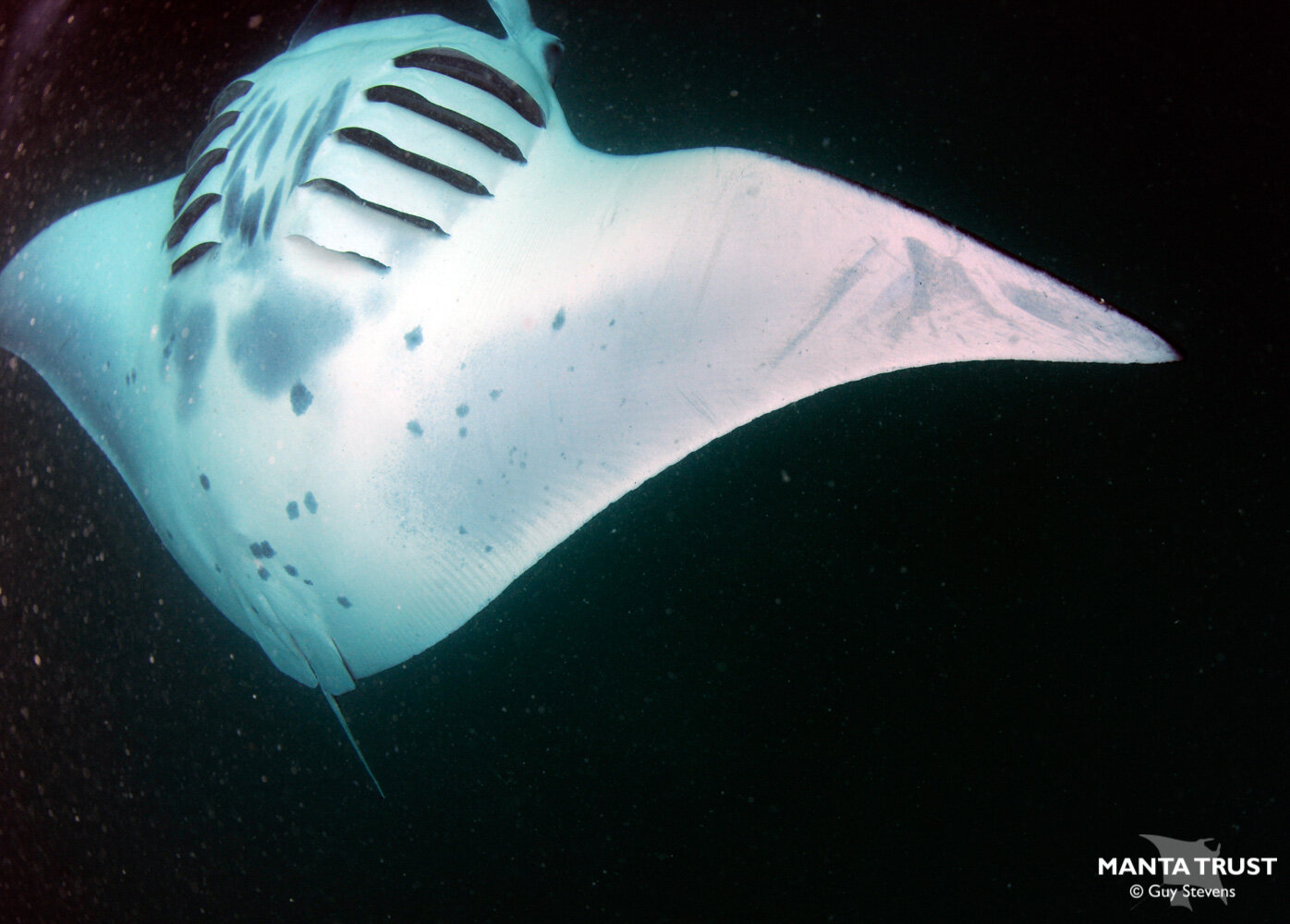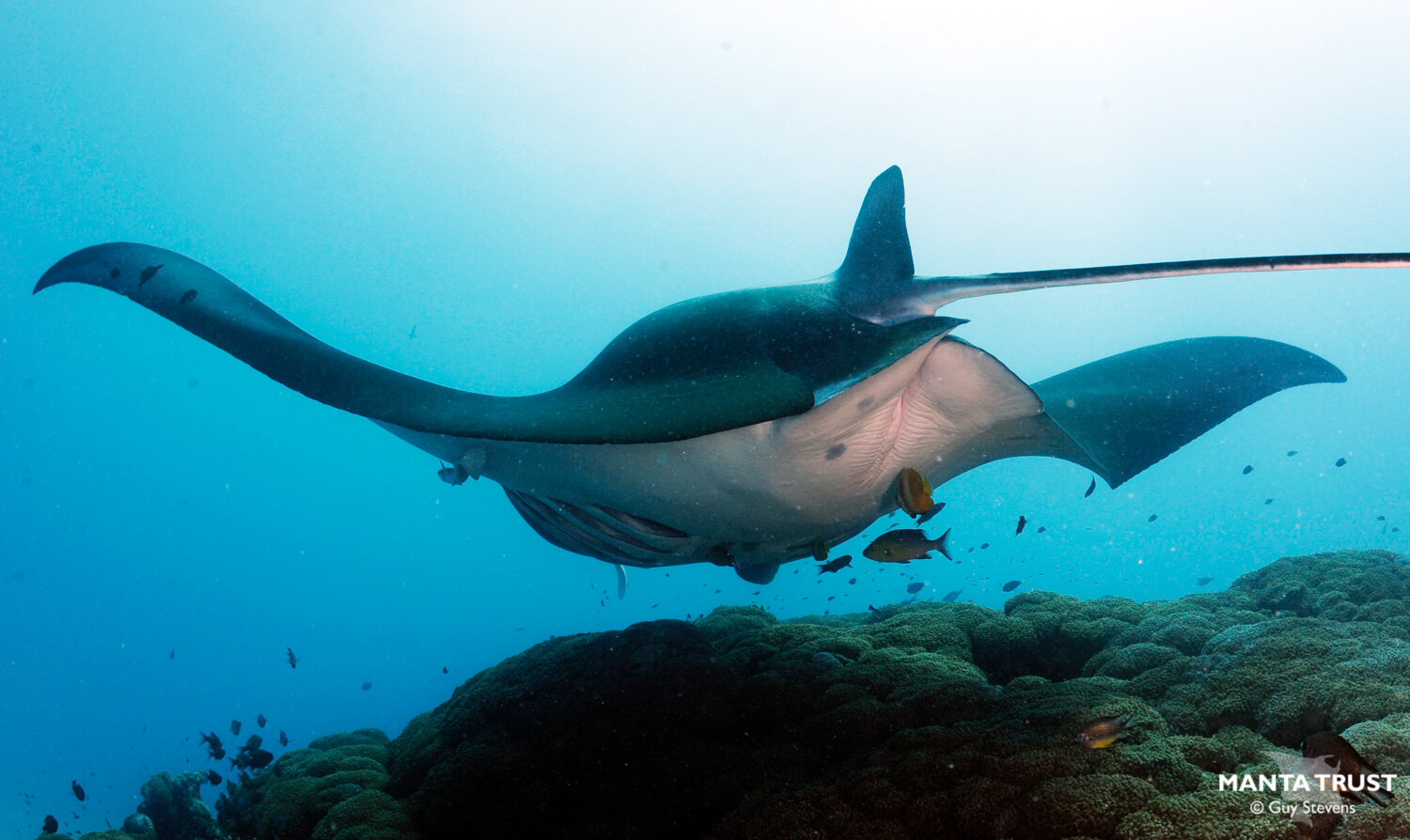Scroll
Manta and devil rays are fascinating creatures with diverse and complex behaviours. The more we study them the more we are unravelling the mysteries of their feeding, cleaning and reproductive ecology. However, there is still a lot more to learn!

FEEDING STRATEGIES
When manta and devil rays open their mouths to feed, unfurling those hornlike projections, the cephalic fins, they transform into feeding machines. The once flattened body and mouth becomes a giant black hole, with the pectoral fins serving as wings that power the ray through the water.
To maximise their planktonic rewards for the energy they expend while feeding, mobulid rays have evolved a wide variety of feeding strategies. The overall feeding technique is simple. The manta swims through the water with its massive mouth agape, and the paddle-like cephalic (head) fins unfurl in front of the mouth to funnel plankton-rich water through their specially adapted gills. But variations in the rays’ swimming positions, and the strategies they use as a group, are key to their feeding success. These strategies can often be complex, requiring coordination among multiple individuals to enhance feeding efficiency. Only recently have scientists begun studying these techniques in depth, but to date, a total of eight different feeding strategies have already been described.







Cleaning Behaviour
The world’s oceans can be an itchy place for its inhabitants to live, especially the larger ones, whose bodies present a much bigger target for waterborne parasites. On land, larger animals such as birds and mammals often cope with this problem by grooming and cleaning themselves and other members of their social group, using teeth, hands, beaks and claws to rid themselves of these irritating parasites. But fish like mobula and manta rays do not have hands or beaks, so they have found an animal group to do the job for them.


These animals are called cleaners, comprising mostly small reef fishes, although many shrimp species have evolved to become specialised cleaners as well. The cleaners set up shop at specific locations, usually a prominent reef outcrop or a coral bommie, and a whole host of client species make the trip each day to visit these ‘cleaning stations’.
This relationship between cleaner and client has long fascinated marine ecologists. It is widely showcased as the perfect example of mutually beneficial symbiosis, with both cleaner and client receiving an overall benefit from this cooperative behaviour.

These cleaning stations provide an ideal location to observe manta rays and are therefore often popular dive sites. However, unregulated tourism can have detrimental impacts on both the coral reef and the manta rays. To learn about sustainable tourism, please see our How to Swim With Mantas code of conduct toolkit.

Courtship, Mating & PreGNANCIES
Like all sharks and rays, but unlike the majority of other fish in the sea, mobulid rays reproduce through internal fertilisation; male and female must physically come together to mate. Manta and mobula rays give birth to live young that are small versions of their parents. Ready to fend for themselves, they are completely independent from birth.
Courtship

Courtship rituals and mating events are observed relatively infrequently, and the only documented accounts of a manta ray giving birth come from a single female housed in a public aquarium in Japan. No mobula ray have ever been recorded giving birth. Many gaps still remain in our knowledge of the life history strategies and reproductive behaviour of these animals, and what little we do know is based on limited scientific data, much of which comes from observations on just one species; the reef manta ray.
A male mobulid ray will often try his luck, testing the female’s receptiveness to his amorous advances by shadowing her movements. Positioning himself directly on top of her back. This behaviour soon attracts the attention of more amorous males, which follow in line behind the female to form a manta Conga dance – the ‘courtship train’ has begun!
As many as thirty males line up head-to-tail behind the female as she swims at great speeds, twisting and turning around the reef, even leaping from the water. When multiple receptive females are present, courtship trains can merge or divide. They are in a constant state of flux as new individuals join the queue and old males trail off the back. The trains run hot and cold, reaching periods of explosive speed and energy before slowing again into a graceful procession led by the female.
During the courtship train the female is not really trying to escape her pursuers. Instead, the train is a way for her to assess her suitors; she is testing the males before she makes her choice.
Copulation

Once the female is ready, she slows her swimming speed dramatically, often rising up into the water column as she waits for the male to make his move. The male bites down hard on the end of the female’s wing-tip, working as much as one metre (three feet) of her pectoral fin deep into his mouth. Once the male has a good grip on the female’s pectoral fin, he flips his body around and underneath hers so that they are positioned belly to belly. The male then inserts one of his two claspers into the female’s cloaca and ejacul*tes his sperm with thrusts of his abdominal region. Copulation itself lasts for just thirty seconds and the female remains motionless throughout, while the male continues to beat his pectoral fins, causing the mating couple to spiral around in slow motion in the water column.
When a male mobula or manta bites hold of the female’s pectoral fin during mating it causes minor cuts and abrasions to the upper and lower surface of the female’s wing-tip. The male’s teeth on the lower jaw often leave linear scrapes on the underside of the female’s fins, which are visible as red scratches. These marks quickly fade against the white colouration of the fin’s underside and are often hard to see just a few weeks after mating has occurred.
On manta rays, the male’s grip also causes scarring on the dorsal tips of the female’s pectoral fins, leaving behind white and/or black circular and oblong marks as the upper layers of skin are scraped away by sharp ridges on the supporting branchial arches in the roof of the male’s mouth. These dorsal mating scars are permanent and allow manta scientists to gauge what percentage of the female population consists of fully mature females. The fresh mating wounds on the underside of the pectoral fins also allow scientists to plot recent matings, which can be used to track pregnancies and reproductive trends over the following years.


Another interesting observation of these mating scars is their distribution. Over 95% of mating scars are present only on the female’s left pectoral fin. This trend for lateralisation is found in both species of manta rays around the world and is also observed in a wide variety of other species, including humans, most of whom favour the right-hand side of our bodies.
Pregnancies

All mobulid rays reproduce via aplacental viviparity, meaning they give birth to live young that are hatched from an egg inside the female’s uterus. The pup, which is wrapped in a thin membranous egg case, hatches inside the mother’s oviduct and then feeds on the mother’s uterine milk until it is fully developed and ready to be born. No one has ever observed a manta or mobula ray giving birth naturally in the wild, however captive births of manta rays showed that the pups pop out of their mother’s cloacal opening with their pectoral fins rolled up over their back.
After a gestation period of just over a year, the female reef manta ray gives birth to a single pup (although occasionally they may also give birth to twins) which measures roughly 1.5 metres (5 feet) across from wing-tip to wing-tip at birth.
Under natural conditions, where food is limited and variable, female reef manta rays cannot usually sustain continual reproductive cycles of mating, pregnancies, and births without rest periods in between. The females therefore usually need seasonal gaps in their reproductive cycles to build up their energy reserves.On average, reef manta rays around the world give birth approximately once every 2 to 3 years and in some locations the reproductive rate is as low as one pup every 7 years.
